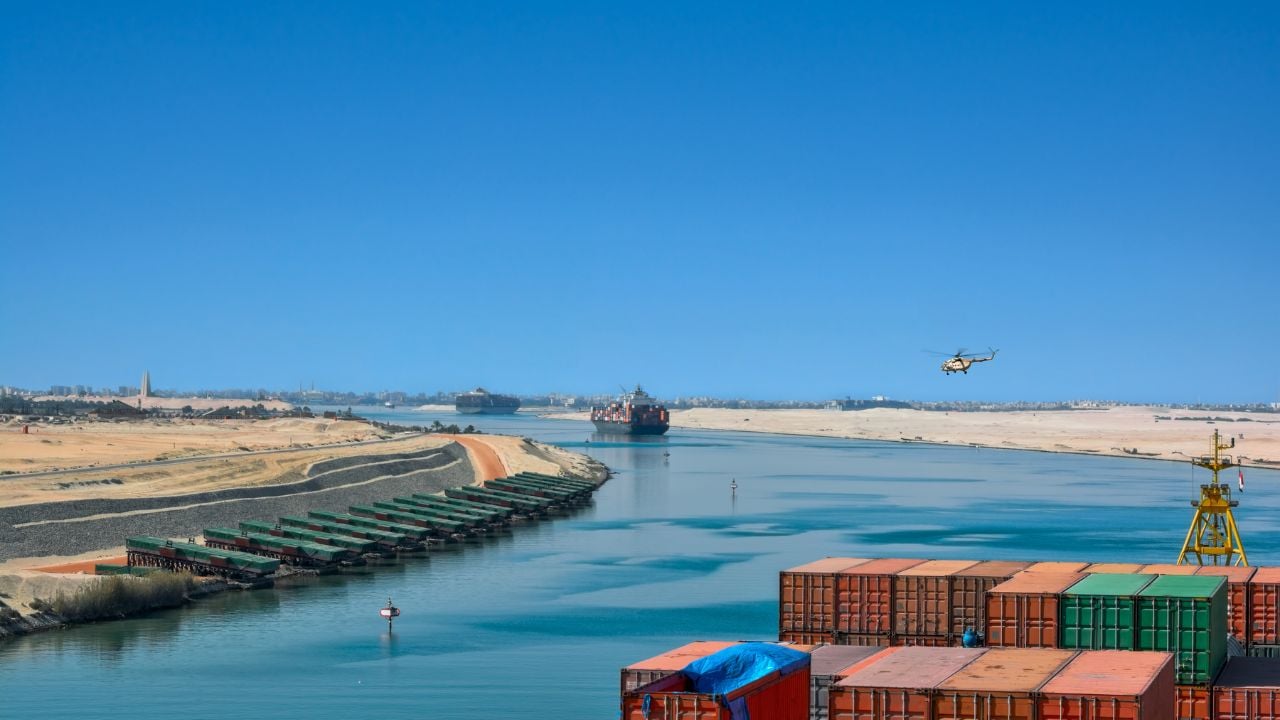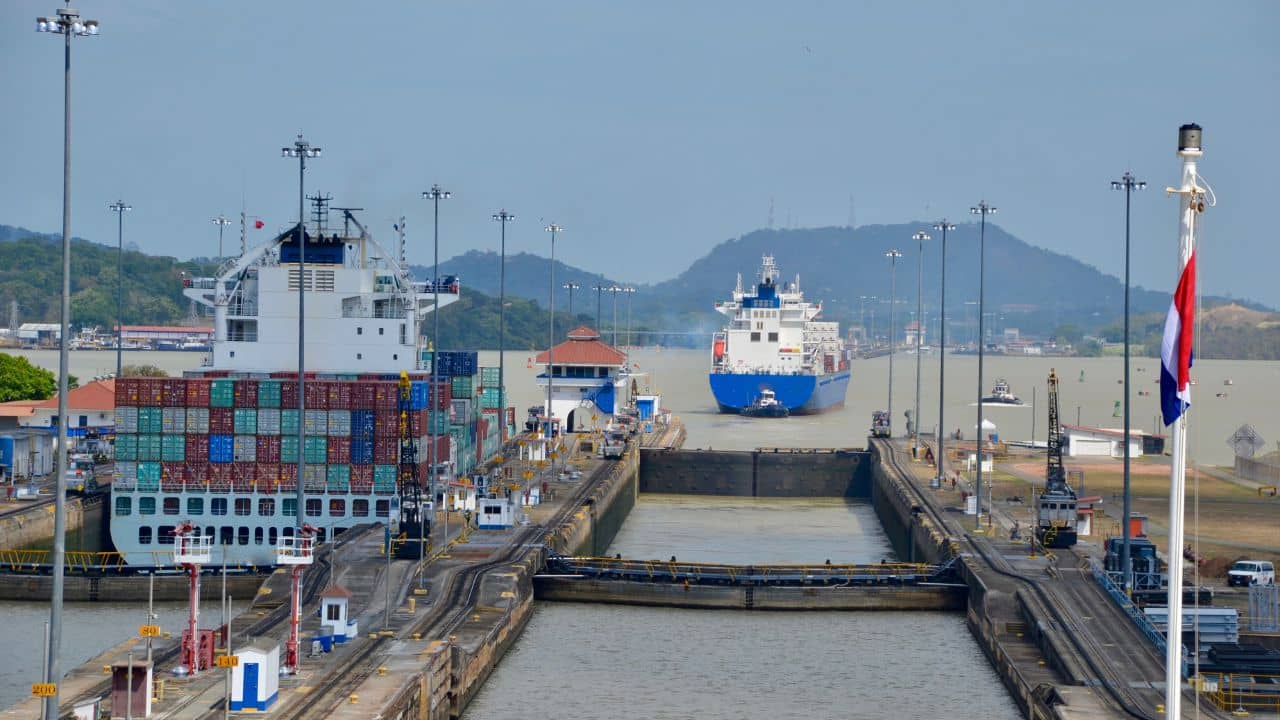
Sailing Through Uncertainty: Current Global Shipping Challenges
8-minutes to read
The crisis in the Suez Canal is causing significant disruptions in global supply chains, with container ships having to re-route around the Cape of Good Hope to avoid Houthi terrorist threats near the Bab al-Mandab Strait, resulting in a considerable impact on the operational capacity of the global container fleet.
In a recent episode of Lodestar’s podcast, host and producer Mike King explores the extent to which these diversions have affected the global container fleet and the repercussions on freight rates, contract negotiations, and transit times.
The discussion also examines the implications of these disruptions leading up to the Chinese New Year factory closures in February and takes a more long-term perspective on the potential consequences for ocean supply chains if such disturbances persist.
Ultimately, the question posed is whether the ‘Suez’ crisis represents the most significant shock to global logistics and trade since the onset of the COVID-19 pandemic.
Mike King: First up, we’re going to get an update on shipping disruption in the Red Sea, where Houthi attacks from Yemen prompted the mass diversion of container ships around the Cape of Good Hope to avoid the Suez Canal and examine what this is doing to freight rates.
Who else could give more insight than Peter Sand, Chief Analyst at Xeneta.
Is this the biggest supply chain disruption we’ve seen since COVID messed up supply chains?
Peter Sand: The disruption that container shipping lines are facing right now in the Red Sea area is a very ugly showcase of geopolitics going wrong again.
We’re witnessing a massive exodus of container services that used to transit this area, now going around the Cape of Good Hope.
To understand the significance of this, look at the rates on key trades disrupted by this, from the Far East going into the Med and North Europe; they went up almost by 100% over the past three weeks.
It’s the biggest disruption we’ve seen since COVID, and there are similarities to the Ever Given incident, but it’s very different from what caused it and how we resolve it in the end.
(The reference to Ever Given is the ship that blocked the Suez Canal during the global COVID-19 pandemic, resulting in the Suez Canal closing for 6 days, which had a domino effect for weeks and months later).
Mike King: How much of the global fleet is now tied up sailing around the Cape, and what does this mean for the supply-demand balance in 2024 if this continues?
Everyone expected excess supply that had been pushing freight rates down in the last part of 2023.
Peter Sand: Carriers can work their magic either way they want.
You could fit anywhere between 1.5 to 2 million teu into all the trades that currently go via the Suez Canal.
If they need to go around the Cape of Good Hope and this becomes a full blockage for container shipping, this is more or less the amount of new tonnage coming on in 2023.
So there is a crunch, but I would say it’s not like shippers or carriers are going to scream for capacity. It is a manageable situation, but of course, there could be a lot of nasty domino effects.
There are a lot of higher costs related to it, and there are also knock-on effects for trades that are not directly impacted by this event, simply from capacity being redeployed or from cargo finding other ways.
I must say that it’s some fireworks we didn’t anticipate, but we saw it with a slight burner already back in late November, and now we’ve just recorded the 24th incident in the Red Sea on the 2nd of January.
And even though Operation Prosperity Guardian is working now, it’s not really making the safe passage that everybody wanted to happen, at least yet.

Mike King: As you referenced, things are getting more expensive to ship. Can you put some numbers on spot freight rate increases we’ve seen in recent weeks, and if you want to make some forecasts about where rates might go from here?
Peter Sand: Three weeks ago, Xeneta advised that during times like this, spot rates do have the potential to jump by as much as 100%.
Fast forward; we are already there. So looking at the rest of January and also into the Chinese Lunar Year, which is about to happen, leading to the peak of the container shipping industry, we may even see a doubling once again.
If we look at the rates into North Europe from the Far East, we are just shy of US$3000 right now and just shy of US$4000 into the Med.
It’s doubled already in the short term, so don’t be surprised if you get another flurry of surcharges thrown at you from the carriers.
Of course, if you’re a shipper, everything is up for negotiation, regardless of the cause of the situation, but rates seem to go only one way as long as the situation is so rich in uncertainty.
We’ve seen Maersk and Hapag Lloyd extending their pauses for another week or so, and that, of course, adds to the inefficient deployment of capacity and higher rates.
Of course, in due time, we’ll also see a knock-on effect on the long-term rates.
We have seen carriers calling for bills of lading clauses that allow them to pass on extra cost, but of course, if your base rate is fairly fixed on a long-term service contract, you will not be phased by the full brute force of what is happening right now on the spot market.
Mike King: As you mentioned earlier, we have got factory closures in February for the Chinese Lunar Year.
How are carriers planning for the coming months, and what does this mean for shippers trying to organize around inventory, particularly for Valentine’s Day sales?
Peter Sand: Either you have goods for Valentine’s Day, or you don’t.
If you have your goods shipped on some of those services that all of a sudden find a longer way, adding 10-14 days of transit times, that could be super business-critical for you.
I think it’s also fair to say that we have seen some of the smaller shippers with goods already in transit really worried because of this massive disruption.
You could do very little to avoid this; the escalation was quite fast. You may have your drawer full of contingency plans to handle something that looked like this but not at this scale, and the magnitude is a bit mind-blowing.
Following mid-December weekend when multiple rockets and missiles were fired at container ships, we saw a massive rerouting.
It’s still what we’re facing right now, so obviously, some smaller shippers, some niche shippers, some with goods that really depend on specific seasons are the hardest hit right now, but in general terms, nobody comes free from a supply chain disaster like the one that we are watching right now.
Mike King: We saw that during the pandemic, a major disruption such as this really threw supply chains out of sync very quickly.
One result was that equipment and ships ended up being in all the wrong places, which resulted in congestion and shortages of boxes on a localized level.
Are you seeing any signs of similar patterns emerging now?
Peter Sand: Not yet. It’s too early to call a shortage of equipment a problem right now, but if this drags on and we see no immediate result to the current situation, you can easily imagine months to pass before we get reinstated safe passage through the Red Sea, there will be an extra need to ensure that equipment is available.
But at the current time, I think uncertainty is the one thing that may push rates up for equipment and prompt carriers to relocate equipment faster than they would otherwise do as a part of their contingency plans to deal with this new situation.
Mike King: When we’ve had disruptions in the past, we’ve seen some shift of cargo from ocean to overland or air. Is your air freight data showing any signs of a shift like this, or are you expecting something like that to happen?
Peter Sand: It’s one thing that we follow quite closely, but there hasn’t been a significant effect on air yet.
Air freight is full of capacity, and there hasn’t been a massive development in terms of rates for air cargo.
We did see a significant uptick in rates in November and December but not something that you can connect to the disruption in the Red Sea.
But then again, we’re talking early January; if we talk late January and the squeeze on some goods and supplies for Valentine’s Day and also in the lead-up to the Chinese Lunar Year, I think we could expect to see some uptick just because of the longer transit times for time-sensitive goods that have nowhere else to go but air.

Mike King: Suez obviously isn’t the only big shipping story at the moment.
We heard last year about dry water levels on the Panama Canal, all because of droughts due to El Nino in the fourth quarter, which was supposed to be the wet season in Panama.
It’s now supposed to be the dry season in Panama, but we had some rain in December. What’s the situation there at the moment?
Peter Sand: Fortunately, we got a bit of rain during December, and that prompted the Panama Canal authorities to adjust their guidance in terms of the capacity for January and February.
They have announced a gradual reduction of capacity, going down to 18 transits in February. That is now held at something like 22 or 24, at least not at the very low end of the scale, and that’s due to some water coming into the watershed of the Panama Canal.
We’re still almost six feet below where we should otherwise be at this point in time because this is normally when the dry season starts and when the watershed is filled up following half a year of the wet season.
But we really didn’t get the wet season. This is something that I have foreseen to impact the year 2024.
We’ve seen many carriers taking out services from Panama and deploying them on the Suez Canal.
Following the most recent disruptions, some are bringing ships back to the Panama Canal, so it may be a little bit of a blessing in disguise that the Panama Canal is not cutting all the way down daily transfers to 18, and container shipping is still receiving some sort of preferred treatment.
Mike King: The two canals, the two key arteries of global trade, are really struggling right now, and things are changing every day, which is a very difficult situation to read for the shipping line network planners.
Source: The Loadstar. This extract from the podcast was edited for clarity. The full podcast can be found on The Loadstar website.
P.S. Easy Freight Ltd helps New Zealand importers & exporters to save money on international freight and reduce mistakes by guiding how to comply with Customs and biosecurity rules.
➔ Contact us now to learn how we can assist you.
